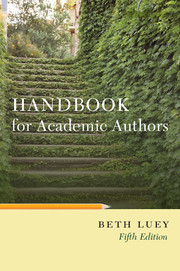Book contents
- Frontmatter
- Contents
- Illustrations
- Preface to the Fifth Edition
- Preface to the Fourth Edition
- Preface to the Third Edition
- Preface to the Second Edition
- Preface to the First Edition
- Chapter 1 The Publishing Partnership
- Chapter 2 Journal Articles
- Chapter 3 Revising a Dissertation
- Chapter 4 Finding a Publisher for the Scholarly Book
- Chapter 5 Working with Your Publisher
- Chapter 6 Multiauthor Books and Anthologies
- Chapter 7 Finding a Publisher for the College Textbook
- Chapter 8 Working with Your Textbook Publisher
- Chapter 9 Books for General Readers
- Chapter 10 The Mechanics of Authorship
- Chapter 11 Costs and Prices
- Chapter 12 Born Digital
- Bibliography
- Index
Chapter 9 - Books for General Readers
Published online by Cambridge University Press: 02 December 2010
- Frontmatter
- Contents
- Illustrations
- Preface to the Fifth Edition
- Preface to the Fourth Edition
- Preface to the Third Edition
- Preface to the Second Edition
- Preface to the First Edition
- Chapter 1 The Publishing Partnership
- Chapter 2 Journal Articles
- Chapter 3 Revising a Dissertation
- Chapter 4 Finding a Publisher for the Scholarly Book
- Chapter 5 Working with Your Publisher
- Chapter 6 Multiauthor Books and Anthologies
- Chapter 7 Finding a Publisher for the College Textbook
- Chapter 8 Working with Your Textbook Publisher
- Chapter 9 Books for General Readers
- Chapter 10 The Mechanics of Authorship
- Chapter 11 Costs and Prices
- Chapter 12 Born Digital
- Bibliography
- Index
Summary
In the idea of literature one essential element is some relation to a general and common interest of man – so that what applies only to a local, or professional, or merely personal interest, even though presenting itself in the shape of a book, will not belong to literature.
Thomas de QuinceySerious nonfiction – whether written by journalists, professional writers, or academics – has become very popular. Allan Bloom's Closing of the American Mind and Stephen Hawking's Brief History of Time both appeared on The New York Times' best-seller list for weeks on end (Hawking's for nearly two years), and books by scholars such as Harry Frankfurt, Steven Pinker, and Elaine Pagels have made frequent, if briefer, appearances. Still more books by academic writers, though not best-sellers, have sold in respectable numbers, sometimes for several years.
Academics have many reasons to write for general readers. Trade books bring their authors more money than monographs do, though usually not as much as textbooks. They also allow scholars to communicate with people other than their colleagues and students. Writing for a nonspecialized audience conveys a researcher's own discoveries, the state of a discipline, enthusiasm for work, or the urgency of an issue or cause to significant numbers of people. It is another way to make a difference: to influence public policy, interest people in an important subject, reduce ignorance about a discipline, or bring readers up to date on important research.
- Type
- Chapter
- Information
- Handbook for Academic Authors , pp. 150 - 172Publisher: Cambridge University PressPrint publication year: 2009



